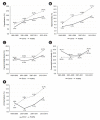Metabolic risks in living kidney donors in South Korea
- PMID: 34781645
- PMCID: PMC8685357
- DOI: 10.23876/j.krcp.20.271
Metabolic risks in living kidney donors in South Korea
Abstract
Background: Considering the growing prevalence of Western lifestyles and related chronic diseases occurring in South Korea, this study aimed to explore the progression of metabolic risk factors in living kidney donors.
Methods: This study enrolled living kidney donors from seven hospitals from 1982 to 2016. The controls were individuals that voluntarily received health check-ups from 1995 to 2016 that were matched with donors according to age, sex, diabetes status, baseline estimated glomerular filtration rate, and date of the medical record. Data on hyperuricemia, hypertension, hypercholesterolemia, and overweight/obesity were collected to determine metabolic risks. Logistic regressions with interaction terms between the medical record date and donor status were used to compare the trends in metabolic risks over time in the two groups.
Results: A total of 2,018 living kidney donors and matched non-donors were included. The median age was 44.0 years and 54.0% were women. The living kidney donors showed a lower absolute prevalence for all metabolic risk factors, except for those that were overweight/obese, than the non-donors. The proportion of subjects that were overweight/obese was consistently higher over time in the donor group. The changes over time in the prevalence of each metabolic risk were not significantly different between groups, except for a lower prevalence of metabolic risk factors ≥ 3 in donors.
Conclusion: Over time, metabolic risks in living kidney donors are generally the same as in non-donors, except for a lower prevalence of metabolic risk factors ≥3 in donors.
Keywords: Hypercholesterolemia; Hyperuricemia; Kidney transplantation; Living donors; Risk factors.
Conflict of interest statement
All authors have no conflicts of interest to declare.
Figures



Similar articles
-
The Minnesota attributable risk of kidney donation (MARKD) study: a retrospective cohort study of long-term (> 50 year) outcomes after kidney donation compared to well-matched healthy controls.BMC Nephrol. 2023 May 1;24(1):121. doi: 10.1186/s12882-023-03149-7. BMC Nephrol. 2023. PMID: 37127560 Free PMC article.
-
Long-term Mortality Risks Among Living Kidney Donors in Korea.Am J Kidney Dis. 2020 Jun;75(6):919-925. doi: 10.1053/j.ajkd.2019.09.015. Epub 2019 Dec 19. Am J Kidney Dis. 2020. PMID: 31866225
-
Long term metabolic and renal outcomes of kidney donors compared to controls with excellent kidney function.BMC Nephrol. 2019 Jan 31;20(1):30. doi: 10.1186/s12882-019-1214-4. BMC Nephrol. 2019. PMID: 30704441 Free PMC article.
-
Long-term Medical Outcomes of Living Kidney Donors.Mayo Clin Proc. 2022 Nov;97(11):2107-2122. doi: 10.1016/j.mayocp.2022.06.013. Epub 2022 Oct 7. Mayo Clin Proc. 2022. PMID: 36216599 Free PMC article. Review.
-
Risks for donors associated with living kidney donation: meta-analysis.Br J Surg. 2022 Jul 15;109(8):671-678. doi: 10.1093/bjs/znac114. Br J Surg. 2022. PMID: 35612960 Free PMC article.
Cited by
-
Prediction of post-donation renal function using machine learning techniques and conventional regression models in living kidney donors.J Nephrol. 2024 Jul;37(6):1679-1687. doi: 10.1007/s40620-024-02027-1. Epub 2024 Jul 29. J Nephrol. 2024. PMID: 39073700
-
Prediction tool for renal adaptation after living kidney donation using interpretable machine learning.Front Med (Lausanne). 2023 Jul 14;10:1222973. doi: 10.3389/fmed.2023.1222973. eCollection 2023. Front Med (Lausanne). 2023. PMID: 37521345 Free PMC article.
-
Perception regarding live kidney donation in the general population of South Korea.PLoS One. 2022 Aug 4;17(8):e0272495. doi: 10.1371/journal.pone.0272495. eCollection 2022. PLoS One. 2022. PMID: 35925947 Free PMC article.
-
Strategies for Monitoring and Supporting Living Donors in Korea: An Expert Position Paper.J Korean Med Sci. 2025 Mar 17;40(10):e33. doi: 10.3346/jkms.2025.40.e33. J Korean Med Sci. 2025. PMID: 40098490 Free PMC article.
-
High-fat diet promotes lipotoxicity in the podocytes of uninephrectomized mice: a targeted lipidomics and kidney podocyte-specific analysis.Cell Death Discov. 2025 Apr 23;11(1):193. doi: 10.1038/s41420-025-02419-7. Cell Death Discov. 2025. PMID: 40268915 Free PMC article.
References
-
- United States Renal Data System (USRDS) Bethesda (MD): National Institutes of Health, National Institute of Diabetes and Digestive and Kidney Diseases; 2019. 2018 USRDS annual data report [Internet] [cited 2021 May 27]. Available from: https://usrds.org/media/2283/2018_volume_2_esrd_in_the_us.pd.
-
- ESRD Registry Committee, Korean Society of Nephrology . Korea: ESRD Registry Committee, Korean Society of Nephrology; 2018. Current renal replacement therapy in Korea: Insan Memorial Dialysis Registry, 2018 [Internet] [cited 2021 May 27]. Available from: http://www.ksn.or.kr/rang_board/list.html?code=sinchart.
-
- Korean Organ Transplantation Registry (KOTRY) Seoul: KOTRY; 2018. KOTRY anuual data report [Internet] [cited 2021 May 27]. Available from: http://www.kotry.org/ko/
-
- Tekin S, Yavuz HA, Yuksel Y, et al. Kidney transplantation from elderly donor. Transplant Proc. 2015;47:1309–1311. - PubMed
-
- Davis CL, Delmonico FL. Living-donor kidney transplantation: a review of the current practices for the live donor. J Am Soc Nephrol. 2005;16:2098–2110. - PubMed
Grants and funding
LinkOut - more resources
Full Text Sources

